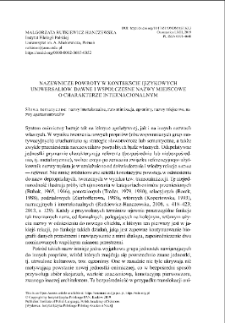
Obiekt
Tytuł: Nazewnicze powroty w kontekście językowych uniwersaliów. Dawne i współczesne nazwy miejscowe o charakterze internacjonalnym
Wydawca:
Instytut Języka Polskiego Polskiej Akademii Nauk
Miejsce wydania:
Typ obiektu:
Abstrakt:
The article concerns the history and unique nature of local names derived from exonyms, such as Alexandria, Spain and Lisbon. It describes both past and contemporary onyms, i.e. the names of housing estates, such as Little Tuscany, and apartment buildings, such as Rome, London and Mont Blanc, which are the continuations of the toponymic model launched in the past. The author embeds this model of names in a broader cultural context by referring to language universals. In addition to the rich collection of the oldest biblical names that have been transferred to present names, transfers of old names can be observed among contemporary names. In the past (in the early nineteenth and twentieth centuries), these were mainly the names of countries and, less frequently, those of cities, lands and geographic objects. Today, toponyms are usually based on the names of European cities, attractive geographic objects (lakes, rivers, islands, mountains, volcanoes) and, more rarely, states. While the names of biblical lands were fascinating and attractive in the past, they are almost absent in contemporary names, and if they are present, they concern culturally fixed images such as that of Eden. Both formerly and today, the creators of this kind of names show a longing for the creation of a new world which is no longer inhabited by God in a strictly religious dimension, but a secular one where happiness, peace and joy are sought. In both characterised spaces, the names transferred serve commemorative functions and also imitate coveted spaces which cannot be physically inhabited but can at least be imitated by their names. Formerly, they were real imago mundi representing sacred places (e.g. names such as Calvary). Today, they are created as part of the contemporary architectural tendency for coherence in planning space, names and design.
Czasopismo/Seria/cykl:
Tom:
Strona pocz.:
Strona końc.:
Szczegółowy typ zasobu:
Identyfikator zasobu:
10.17651/ONOMAST.63.3 ; oai:rcin.org.pl:106284
Język:
Język streszczenia:
Prawa:
Prawa zastrzeżone - dostęp nieograniczony
Dostęp:
Kolekcje, do których przypisany jest obiekt:
- Repozytorium Cyfrowe Instytutów Naukowych > Kolekcje Partnerów > Instytut Języka Polskiego PAN > Dziedziny nauki
- Repozytorium Cyfrowe Instytutów Naukowych > Kolekcje Partnerów > Instytut Języka Polskiego PAN > Czasopisma
- Repozytorium Cyfrowe Instytutów Naukowych > Kolekcje Partnerów > Instytut Języka Polskiego PAN > Dziedziny nauki > Nauki humanistyczne
- Repozytorium Cyfrowe Instytutów Naukowych > Kolekcje Partnerów > Instytut Języka Polskiego PAN > Dziedziny nauki > Nauki humanistyczne > Językoznawstwo
- Repozytorium Cyfrowe Instytutów Naukowych > Kolekcje Partnerów > Instytut Języka Polskiego PAN > Dziedziny nauki > Nauki humanistyczne > Językoznawstwo > Onomastyka
- Repozytorium Cyfrowe Instytutów Naukowych > Piśmiennictwo > Czasopisma/Artykuły
Data ostatniej modyfikacji:
2 paź 2020
Data dodania obiektu:
21 sty 2020
Liczba pobrań / odtworzeń:
1056
Wszystkie dostępne wersje tego obiektu:
https://rcin.org.pl/publication/134426
Wyświetl opis w formacie RDF:
Wyświetl opis w formacie RDFa:
Wyświetl opis w formacie OAI-PMH:
Obiekty Podobne
Pracownia Toponomastyczna IJP PAN
Pracownia Toponomastyczna IJP PAN
Pracownia Toponomastyczna IJP PAN
Pracownia Toponomastyczna IJP PAN
Pracownia Toponomastyczna IJP PAN
Pracownia Toponomastyczna IJP PAN
Pracownia Toponomastyczna IJP PAN

 INSTYTUT ARCHEOLOGII I ETNOLOGII POLSKIEJ AKADEMII NAUK
INSTYTUT ARCHEOLOGII I ETNOLOGII POLSKIEJ AKADEMII NAUK
 INSTYTUT BADAŃ LITERACKICH POLSKIEJ AKADEMII NAUK
INSTYTUT BADAŃ LITERACKICH POLSKIEJ AKADEMII NAUK
 INSTYTUT BADAWCZY LEŚNICTWA
INSTYTUT BADAWCZY LEŚNICTWA
 INSTYTUT BIOLOGII DOŚWIADCZALNEJ IM. MARCELEGO NENCKIEGO POLSKIEJ AKADEMII NAUK
INSTYTUT BIOLOGII DOŚWIADCZALNEJ IM. MARCELEGO NENCKIEGO POLSKIEJ AKADEMII NAUK
 INSTYTUT BIOLOGII SSAKÓW POLSKIEJ AKADEMII NAUK
INSTYTUT BIOLOGII SSAKÓW POLSKIEJ AKADEMII NAUK
 INSTYTUT CHEMII FIZYCZNEJ PAN
INSTYTUT CHEMII FIZYCZNEJ PAN
 INSTYTUT CHEMII ORGANICZNEJ PAN
INSTYTUT CHEMII ORGANICZNEJ PAN
 INSTYTUT FILOZOFII I SOCJOLOGII PAN
INSTYTUT FILOZOFII I SOCJOLOGII PAN
 INSTYTUT GEOGRAFII I PRZESTRZENNEGO ZAGOSPODAROWANIA PAN
INSTYTUT GEOGRAFII I PRZESTRZENNEGO ZAGOSPODAROWANIA PAN
 INSTYTUT HISTORII im. TADEUSZA MANTEUFFLA POLSKIEJ AKADEMII NAUK
INSTYTUT HISTORII im. TADEUSZA MANTEUFFLA POLSKIEJ AKADEMII NAUK
 INSTYTUT JĘZYKA POLSKIEGO POLSKIEJ AKADEMII NAUK
INSTYTUT JĘZYKA POLSKIEGO POLSKIEJ AKADEMII NAUK
 INSTYTUT MATEMATYCZNY PAN
INSTYTUT MATEMATYCZNY PAN
 INSTYTUT MEDYCYNY DOŚWIADCZALNEJ I KLINICZNEJ IM.MIROSŁAWA MOSSAKOWSKIEGO POLSKIEJ AKADEMII NAUK
INSTYTUT MEDYCYNY DOŚWIADCZALNEJ I KLINICZNEJ IM.MIROSŁAWA MOSSAKOWSKIEGO POLSKIEJ AKADEMII NAUK
 INSTYTUT PODSTAWOWYCH PROBLEMÓW TECHNIKI PAN
INSTYTUT PODSTAWOWYCH PROBLEMÓW TECHNIKI PAN
 INSTYTUT SLAWISTYKI PAN
INSTYTUT SLAWISTYKI PAN
 SIEĆ BADAWCZA ŁUKASIEWICZ - INSTYTUT TECHNOLOGII MATERIAŁÓW ELEKTRONICZNYCH
SIEĆ BADAWCZA ŁUKASIEWICZ - INSTYTUT TECHNOLOGII MATERIAŁÓW ELEKTRONICZNYCH
 MUZEUM I INSTYTUT ZOOLOGII POLSKIEJ AKADEMII NAUK
MUZEUM I INSTYTUT ZOOLOGII POLSKIEJ AKADEMII NAUK
 INSTYTUT BADAŃ SYSTEMOWYCH PAN
INSTYTUT BADAŃ SYSTEMOWYCH PAN
 INSTYTUT BOTANIKI IM. WŁADYSŁAWA SZAFERA POLSKIEJ AKADEMII NAUK
INSTYTUT BOTANIKI IM. WŁADYSŁAWA SZAFERA POLSKIEJ AKADEMII NAUK


































